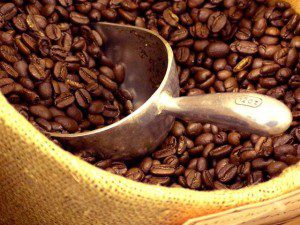By Sayer Ji
Contributing writer for Wake Up World
“It is inhumane, in my opinion, to force people who have a genuine medical need for coffee to wait in line behind people who apparently view it as some kind of recreational activity.” — David Barry
That coffee possesses ‘drug-like’ properties, we know quite well. Some of us in fact revel in its addictive properties, as it comes with a certain — albeit a tad bit pathological — industriousness. After all, is there anyone more disciplined/obsessed than a coffee drinker — at least, that is, when it comes to acquiring and drinking coffee? You can set your clocks with exactitude to the performance of their daily coffee-associated machinations — they themselves often setting their coffee makers to clocks, so as not to delay or miss an opportunity to imbibe. The type of sober religiosity required to turn drinking a beverage into a ritual is known only by a few Zen tea drinkers and quite possibly billions of habitual coffee drinkers.
[pro_ad_display_adzone id=”110028″]
Let us also not forget that one of the first documented uses of coffee over 500 years ago was in the Sufi monasteries of Yemen where coffee was known as qahhwat al-bun, or, the ‘wine of the bean,’ the phrase which provided the etymological origin of the word coffee. Once lauded as a “miracle drug” and used as a sacrament in late-night rituals to invoke the sensation of God within revelers, still today, coffee drinkers are known to cast themselves into bouts of coffee-drinking induced reverie and enthusiasm (literally: en “in” + theos “god” or “god-filled”) by drinking this strangely intoxicating, and yet somehow still sobering concoction.
It is interesting that even addictions can be viewed as a form of ritual — albeit degenerated ones (i.e. less regenerative than truly sacred ones), performed with less consciousness than would be expected of a holy, whole-making act. But that cup of Joe gets us up in the morning to perform our secular duties, which says a lot considering what many of us are forced or coerced to do for a living.
While many attribute coffee’s vice-like hold on their physiology to its caffeine content, there is much more going on than a fixation on a stimulant. Its been known for ove a quarter of a century that coffee contains a compound with powerful opiate-like properties and which is found within both caffeinated and decaffeinated forms. The average cup of coffee contains five times the amount needed for what is known as the half maximal effective concentration (ED50), which is a measure of a drug’s potency indicating a response halfway between the baseline and maximum. The ‘narcotic’ properties of coffee are no doubt due to a complex interplay between a wide range of compounds, but at least one compound has been identified that is responsible for increasing the release of our own opioids within the body: namely, cafestrol, a diterprene found within the oil of coffee, known to have potent pain-killing properties.
Coffee is also a ‘brain-booster’ and contains a compound called trigonelline which both stimulates the release of dopamine (not unlike cocaine), and stimulates neurite outgrowth, which involves the extension of dendrites and axons in neurons and which may compensate and rescue damaged neuronal networks in the aging brain. One of the greatest nutrition philosophers of all time, Rudolf Hauschka, described coffee’s affect on our body-mind as follows:
Coffee makes us more aware of our bodily structure. And since this structure is so wise and logical, our thoughts become logical in their awareness of it. Coffee thus helps thinking to find a firm foundation. The connection between bodily being and thinking, keeps calling itself to our attention. Coffee has the same effect on digestion that thought has on our upper man, i.e., a properly ordered metabolism goes hand in hand with orderly thinking. Both are founded on a properly ordered physical structure.
—Rudolf Hauschka, Nutrition: A Holistic Approach
Coffee is also one of the only sources of “bitters” remaining in the sweet-fixated Western diet, which sadly comes with a certificate of guarantee that the bearer will likely develop type 2 diabetes, heart disease or cancer at some point in their life. Could the extreme bitterness of coffee be the reason why it has been repeatedly shown to reduce type 2 diabetes risk, as it is one of the only ways we can balance out the highly inappropriate excesses of carbohydrate in our modern dietary configuration? We don’t normally think of grains as sweet, but they are on the glycemic index. Puffed rice, for instance, can make the blood sweeter than white sugar which is why carbs are known as “crouching diabetes, hidden sugar.” Coffee contains a wide range of blood-glucose and insulin sensitizing compounds, making it an ideal complement to a carbohydrate-deranged diet.
Coffee also awakens and stimulates the Qi, as it is known in the Chinese medical tradition. This was recently discussed in an article entitled “Similarity between coffee effects and qi-stimulating events” which can be read here. While raising Qi through exercise and energy work is the ideal situation, coffee provides a short-cut which is the modus operandi in the modern world: instant gratification in exchange for (energy) indebtedness.
When used responsibly,* however, coffee may be a great boon to health. There are in fact over 40 health conditions which may respond favorably to its use, as documented on GreenMedInfo’s coffee research page.
*Responsibly could be defined as using it as a medicine, occasionally versus every day. Good luck with that!
Recommended articles by Sayer Ji:
- If Cannabis Can Kill “Incurable” Brain Cancer, Why Is It Criminalized?
- The Powerful Aspirin Alternative Your Doctor Never Told You About
- 13 Evidence-Based Medicinal Properties of Coconut Oil
- Group Drumming Better Than Prozac, Study Suggests
- 25 Cancer Stem-Cell Killing Foods That Are Smarter Than Chemo and Radiation
- How Pomegranate Puts Chemo and Radiation to Shame
- How Turmeric Can Save the Aging Brain From Dementia and Premature Death
- Dramatic Recovery in Parkinson’s Patient with Gluten Free Diet
- 6 Bodily Tissues That Can Be Regenerated Through Nutrition
- Fluoride Literally Turns the Pineal Gland to Stone, Research Suggests
- Why All Diabetics Should Know About Turmeric
- Wheat Contains Not One But 23K Potentially Harmful Proteins
About the author:
Sayer Ji is the founder of Greenmedinfo.com, a reviewer at the International Journal of Human Nutrition and Functional Medicine, Co-founder and CEO of Systome Biomed, Vice Chairman of the Board of the National Health Federation, and Steering Committee Member of the Global Non-GMO Foundation.
For more, visit GreenMedInfo.com and Facebook.com/GreenMedInfo, or sign up for GreenMedInfo’s free e-Newsletter.
© GreenMedInfo LLC. This work is reproduced and distributed with the permission of GreenMedInfo LLC. Want to learn more from GreenMedInfo? Sign up for their newsletter here.
[pro_ad_display_adzone id=”110027″]








